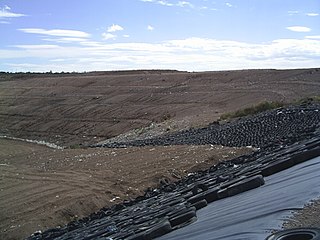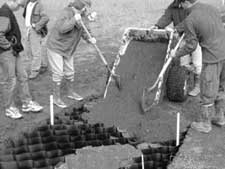Related Research Articles

Geotechnical engineering is the branch of civil engineering concerned with the engineering behavior of earth materials. It uses the principles of soil mechanics and rock mechanics for the solution of its respective engineering problems. It also relies on knowledge of geology, hydrology, geophysics, and other related sciences. Geotechnical (rock) engineering is a subdiscipline of geological engineering.

Subsidence is a general term for downward vertical movement of the Earth's surface, which can be caused by both natural processes and human activities. Subsidence involves little or no horizontal movement, which distinguishes it from slope movement.

Soil liquefaction occurs when a cohesionless saturated or partially saturated soil substantially loses strength and stiffness in response to an applied stress such as shaking during an earthquake or other sudden change in stress condition, in which material that is ordinarily a solid behaves like a liquid. In soil mechanics, the term "liquefied" was first used by Allen Hazen in reference to the 1918 failure of the Calaveras Dam in California. He described the mechanism of flow liquefaction of the embankment dam as:
If the pressure of the water in the pores is great enough to carry all the load, it will have the effect of holding the particles apart and of producing a condition that is practically equivalent to that of quicksand... the initial movement of some part of the material might result in accumulating pressure, first on one point, and then on another, successively, as the early points of concentration were liquefied.

Soil mechanics is a branch of soil physics and applied mechanics that describes the behavior of soils. It differs from fluid mechanics and solid mechanics in the sense that soils consist of a heterogeneous mixture of fluids and particles but soil may also contain organic solids and other matter. Along with rock mechanics, soil mechanics provides the theoretical basis for analysis in geotechnical engineering, a subdiscipline of civil engineering, and engineering geology, a subdiscipline of geology. Soil mechanics is used to analyze the deformations of and flow of fluids within natural and man-made structures that are supported on or made of soil, or structures that are buried in soils. Example applications are building and bridge foundations, retaining walls, dams, and buried pipeline systems. Principles of soil mechanics are also used in related disciplines such as geophysical engineering, coastal engineering, agricultural engineering, hydrology and soil physics.

A leachate is any liquid that, in the course of passing through matter, extracts soluble or suspended solids, or any other component of the material through which it has passed.

Geosynthetics are synthetic products used to stabilize terrain. They are generally polymeric products used to solve civil engineering problems. This includes eight main product categories: geotextiles, geogrids, geonets, geomembranes, geosynthetic clay liners, geofoam, geocells and geocomposites. The polymeric nature of the products makes them suitable for use in the ground where high levels of durability are required. They can also be used in exposed applications. Geosynthetics are available in a wide range of forms and materials. These products have a wide range of applications and are currently used in many civil, geotechnical, transportation, geoenvironmental, hydraulic, and private development applications including roads, airfields, railroads, embankments, retaining structures, reservoirs, canals, dams, erosion control, sediment control, landfill liners, landfill covers, mining, aquaculture and agriculture.

Geotextiles are permeable fabrics which, when used in association with soil, have the ability to separate, filter, reinforce, protect, or drain. Typically made from polypropylene or polyester, geotextile fabrics come in two basic forms: woven and nonwoven.

Geocomposite is a composition / combination of two or more geosynthetic materials to perform multiple number of geosynthetic functions for specific civil engineering application(s) the purpose of providing this composition is to minimize the application costs whereas the technical properties of the soil or the geotechnical structure are enhanced.
A geomembrane is very low permeability synthetic membrane liner or barrier used with any geotechnical engineering related material so as to control fluid migration in a human-made project, structure, or system. Geomembranes are made from relatively thin continuous polymeric sheets, but they can also be made from the impregnation of geotextiles with asphalt, elastomer or polymer sprays, or as multilayered bitumen geocomposites. Continuous polymer sheet geomembranes are, by far, the most common.

A landfill liner, or composite liner, is intended to be a low permeable barrier, which is laid down under engineered landfill sites. Until it deteriorates, the liner retards migration of leachate, and its toxic constituents, into underlying aquifers or nearby rivers, causing potentially irreversible contamination of the local waterway and its sediments.

UTEXAS is a slope stability analysis program written by Stephen G. Wright of the University of Texas at Austin. The program is used in the field of civil engineering to analyze levees, earth dams, natural slopes, and anywhere there is concern for mass wasting. UTEXAS finds the factor of safety for the slope and the critical failure surface. Recently the software was used to help determine the reasons behind the failure of I-walls during Hurricane Katrina.

Cellular confinement systems (CCS)—also known as geocells—are widely used in construction for erosion control, soil stabilization on flat ground and steep slopes, channel protection, and structural reinforcement for load support and earth retention. Typical cellular confinement systems are geosynthetics made with ultrasonically welded high-density polyethylene (HDPE) strips or novel polymeric alloy (NPA)—and expanded on-site to form a honeycomb-like structure—and filled with sand, soil, rock, gravel or concrete.
A geonet is a geosynthetic material similar in structure to a geogrid, consisting of integrally connected parallel sets of ribs overlying similar sets at various angles for in-plane drainage of liquids or gases. Geonets are often laminated with geotextiles on one or both surfaces and are then referred to as drainage geocomposites. They are competitive with other drainage geocomposites having different core configurations.
Slope stability analysis is a static or dynamic, analytical or empirical method to evaluate the stability of earth and rock-fill dams, embankments, excavated slopes, and natural slopes in soil and rock. Slope stability refers to the condition of inclined soil or rock slopes to withstand or undergo movement. The stability condition of slopes is a subject of study and research in soil mechanics, geotechnical engineering and engineering geology. Analyses are generally aimed at understanding the causes of an occurred slope failure, or the factors that can potentially trigger a slope movement, resulting in a landslide, as well as at preventing the initiation of such movement, slowing it down or arresting it through mitigation countermeasures.
SVSLOPE is a slope stability analysis program developed by SoilVision Systems Ltd.. The software is designed to analyze slopes using both the classic "method of slices" as well as newer stress-based methods. The program is used in the field of civil engineering to analyze levees, earth dams, natural slopes, tailings dams, heap leach piles, waste rock piles, and anywhere there is concern for mass wasting. SVSLOPE finds the factor of safety or the probability of failure for the slope. The software makes use of advanced searching methods to determine the critical failure surface.
Solid waste landfills can be affected by seismic activity. The tension in a landfill liner rises significantly during an earthquake, and can lead to stretching or tearing of the material. The top of the landfill may crack, and methane collection systems can be moved relative to the cover.

Geotechnical centrifuge modeling is a technique for testing physical scale models of geotechnical engineering systems such as natural and man-made slopes and earth retaining structures and building or bridge foundations.

Timothy D. Stark is a Professor of Geotechnical Engineering in the Department of Civil and Environmental Engineering at the University of Illinois at Urbana–Champaign since 1991. Dr. Stark teaches undergraduate and graduate courses in Foundation Engineering and Earth Structures, respectively, in the Department of Civil and Environmental Engineering at the UIUC and numerous short courses for various entities. Dr. Stark has served as a consultant and expert on a range of domestic and international projects including levees and dams, buildings, bridges, slopes, geosynthetics, seismic issues, waste containment facilities, and highways. Dr. Stark's current research interests include: (1) Design and performance of Earth Dams, Levees, Floodwalls, Landfills, and other Earth Structures, (2) Behavior of Railroad Track Systems and Transitions, (3) Forensic Geotechnical and Foundation Engineering, (4) Static and Seismic Stability of Natural and Man-Made Slopes, (5) Performance of Compacted Structural Fills and Slopes, and (6) Behavior and Design of Waste Containment Facilities.
Ronald Kerry Rowe, OC, FRS, FRSC, FREng is a Canadian civil engineer of Australian birth, one of the pioneers of geosynthetics.

Jean-Pierre Giroud is a French geotechnical engineer and a pioneer of geosynthetics since 1970. In 1977, he coined the words "geotextile" and "geomembrane", thus initiating the "geo-terminology". He is also a past president of the International Geosynthetics Society, member of the US National Academies, and Chevalier de la Légion d'Honneur.
References
- ↑ Sharma, Hari and Reddy, Krishna. 2004. Geoenvironmental Engineering: Site Remediation, Waste Containment, and Emerging Waste Management Technologies. John Wiley & Sons, Inc., Hoboken, New Jersey.
- 1 2 Koerner, R. M. 1993. Geotechnical practice for waste disposal. Array London: Chapman & Hall.
- ↑ Daniel, DE, RM Koerner, R Bonaparte, RE Landreth, DA Carson, and HB Scranton. 1998. Slope Stability of Geosynthetic Clay Liner Test Plots. Journal of Geotechnical and Geoenvironmental Engineering. 124, no. 7: 628-637.
